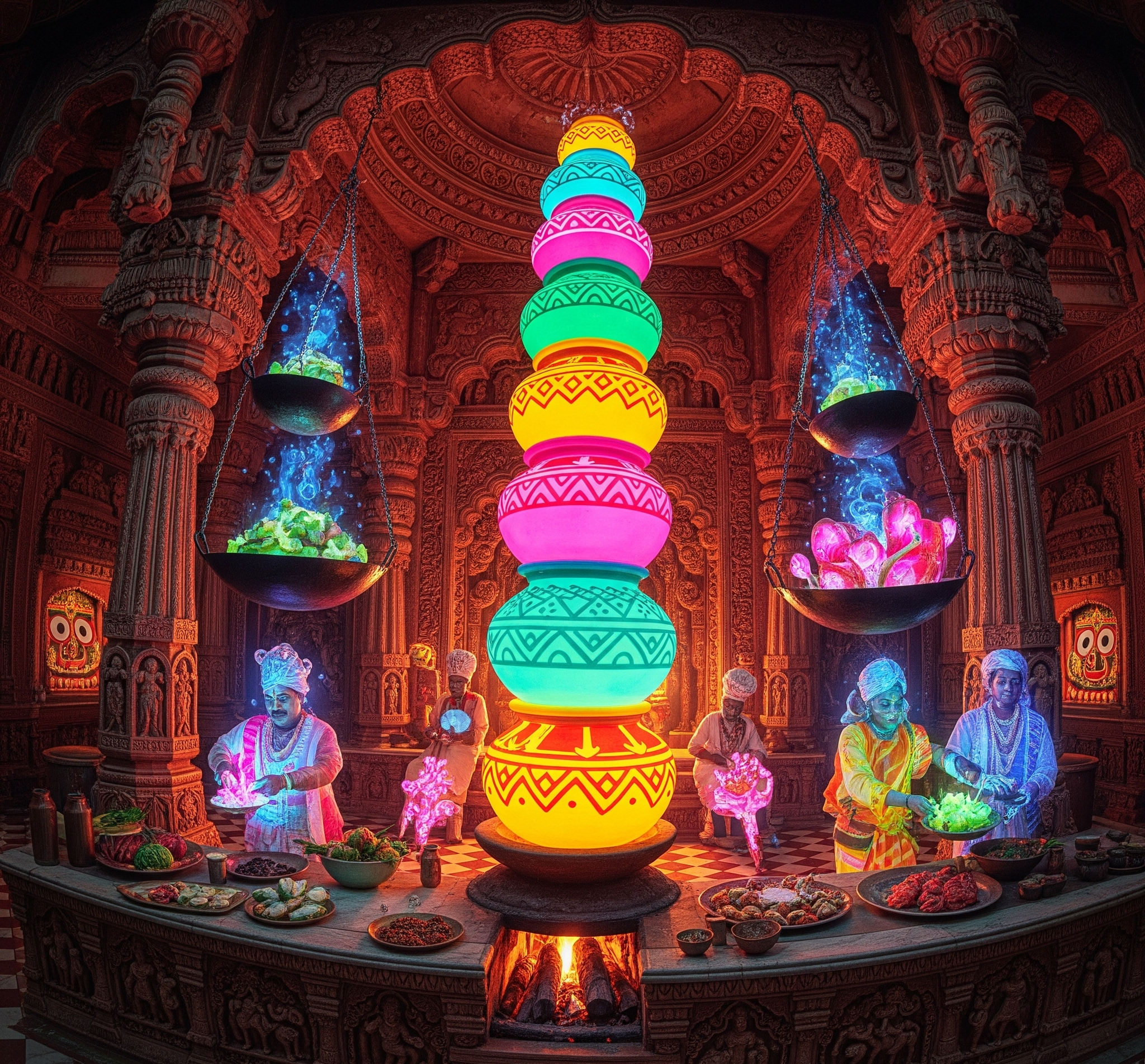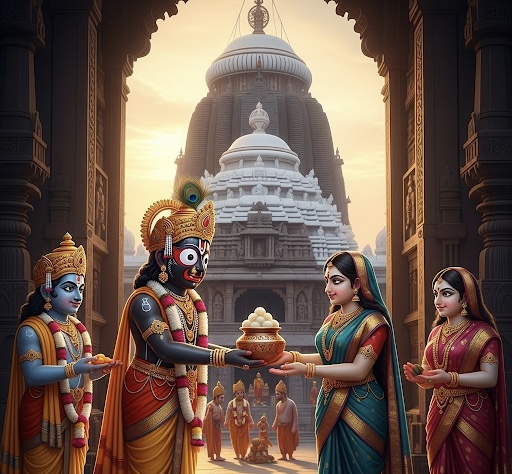The Shree Jagannath Temple in Puri, Odisha, is not only one of the holiest pilgrimage sites in India but also home to the world’s largest and most mysterious kitchen. Nestled within the sacred walls of this 12th-century temple, the Ananda Bazaar and Rosha Ghara (kitchen) are as spiritually significant as the sanctum itself. Here, food transcends mere sustenance—it becomes a ritual, an offering, a miracle.
From the timeless rituals of Mahaprasad preparation to the unexplainable phenomena that defy logic and science, the kitchen of the Jagannath Temple is a marvel of devotion, discipline, and divine mystery. This article explores every detail about its origin, function, cultural significance, and unsolved secrets, presenting an awe-inspiring narrative of faith and sacred tradition.
Origin and Historical Significance of the Jagannath Temple Kitchen
The origin of the Jagannath Temple kitchen can be traced back to the 12th century during the reign of King Anantavarman Chodaganga Deva, the Ganga dynasty monarch who commissioned the temple’s construction. The temple itself was conceived not just as a place of worship, but as a living embodiment of Vedic rituals and daily divine service (seva).
Central to Jagannath worship is the concept of Nitya Seva (eternal service), and offering food to the Lord is an essential part of it. Over the centuries, the temple’s kitchen evolved into a massive yet meticulously managed spiritual ecosystem, sustained by thousands of sevayats (temple servitors) and bound by ageless scriptures and oral traditions.
In Jagannath culture, Mahaprasad—the sacred food offered to the deity—is not merely sanctified but believed to carry divine consciousness. This elevates the kitchen’s role from the functional to the transcendental.
Architecture and Layout of the Temple Kitchen
Located in the south-eastern corner of the temple complex, the kitchen or Rosha Ghara is an architectural and organizational marvel. Sprawled over acres, it includes:
- 752 traditional wood-fired clay ovens or ‘Chulas’.
- Hundreds of large earthen pots (handis) used for cooking.
- Over 600 temple cooks, known as Suaras and Mahasuaras, who are direct descendants of ancient lineages.
- Two main divisions of the kitchen:
- Rosha Ghara (Main Cooking Area)
- Ananda Bazaar (Marketplace for Mahaprasad distribution)
Despite being centuries old, the kitchen remains entirely manual—no modern appliances are used. All cooking is done over firewood using time-honored techniques passed down through generations.
Mahaprasad: Food as Divinity
The food prepared in the Jagannath Temple is not ordinary cuisine. Once offered to the deities, it becomes Mahaprasad, sanctified by the divine presence of Lord Jagannath.
There are two stages of sanctification:
- Bhoga: First offered in the sanctum to the deities.
- Mahaprasad: Once it returns from the sanctum, it is distributed in the Ananda Bazaar and consumed by devotees.
The Mahaprasad is non-discriminatory, meaning anyone—regardless of caste, creed, or religion—can partake of it together, reinforcing Jagannath’s philosophy of universal brotherhood.
Key Dishes and Offerings
There are over 56 varieties of offerings known as Chappan Bhog, including:
- Khechudi (spiced rice)
- Dalma (lentil and vegetable dish)
- Khaja (a dry sweet)
- Pakhala (fermented rice)
- Besara (vegetable curry with mustard paste)
- Puli, Saga, Khatta, and Payasa
Each dish is cooked using only earthenware and firewood, and the use of onion or garlic is strictly prohibited to maintain satvik purity.
Mysterious and Unexplainable Facts of the Kitchen
The Jagannath Temple’s kitchen is not only sacred but steeped in mysteries that defy logic and continue to baffle scientists, pilgrims, and scholars alike.
1. The Exact Quantity Mystery
Every day, food is cooked in set quantities—irrespective of the number of pilgrims. Yet, it is never wasted and never falls short. Whether 5,000 or 500,000 people visit, the Mahaprasad miraculously suffices.
There is no real-time counting system or use of technology to estimate footfall. The Suaras, relying on tradition and intuition, prepare fixed portions. The balance achieved each day is considered a divine miracle of Lord Jagannath.
2. Cooking One Over Another
In a technique known as ‘Matka Sanchalan’, nine earthen pots are stacked vertically on a single fire. Mysteriously, the topmost pot cooks first, followed by the lower ones. This defies all scientific logic related to heat transfer.
Temple cooks regard it as a blessing of the divine and attribute the reverse-cooking method to the goddess Mahalakshmi, the celestial kitchen in-charge.
3. Absence of Smoke
Despite hundreds of clay ovens burning firewood simultaneously, the temple kitchen remains free of smoke. The smoke somehow vanishes or dissipates efficiently, despite the absence of modern ventilation systems. Scholars believe the layout of the temple and airflow design neutralize the smoke, though many attribute it to divine engineering.
4. Sound and Smell Mysteries
While food is being prepared for thousands, one rarely hears the typical clanging of utensils or loud voices. The kitchen maintains a serene, disciplined atmosphere, almost like a spiritual retreat. The aroma, however, fills the entire temple complex—evoking devotion rather than hunger.
Ritual Discipline and Role of Sevayats
The Mahasuaras, Panikarans, and Tadaukaras are specific groups of hereditary servitors responsible for different roles in the kitchen—from collecting water to kneading dough, from making sweets to serving Mahaprasad. Every action follows Shastric injunctions from ancient texts such as the Skanda Purana and Madala Panji.
Once a pot is used, it is considered ritually impure and disposable. The earthenware is broken and discarded daily, emphasizing the sanctity and one-time-use principle of sacred utensils.
No one outside this community is allowed to enter the kitchen or even assist in its operations. The sanctity and secrecy are paramount.
Ananda Bazaar: The World’s Largest Spiritual Food Court
The Ananda Bazaar, adjacent to the kitchen, is where Mahaprasad is distributed. It’s a unique marketplace where thousands gather to purchase and eat Mahaprasad in open community spaces, sitting on the floor and sharing with strangers—eliminating all social hierarchies.
Eating Mahaprasad is considered equivalent to receiving a divine blessing, and devotees carry packets of it back to their homes, treating it as sacred and healing.
Conclusion: A Kitchen Beyond Comprehension
The Jagannath Temple kitchen is not just a place where food is cooked—it is a sacred stage where divine will, human devotion, and ancient wisdom come together. Its architecture, operation, and inexplicable phenomena reveal a spiritual dimension where logic gives way to faith and grace.
The mysterious synchronization of the kitchen—free from technology, measurement tools, or modern intervention—continues to astound scientists and devotees alike, reinforcing the belief that Jagannath is not just a god but a living presence in Puri.
In a world driven by analytics and precision, the kitchen of Lord Jagannath reminds us that faith, ritual, and selfless service have a power of their own—a power that can create miracles every single day.




